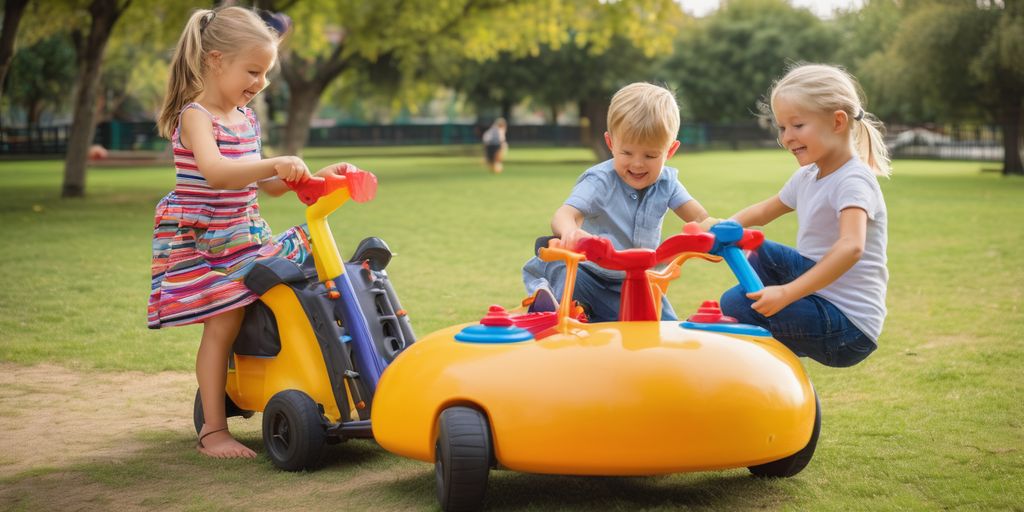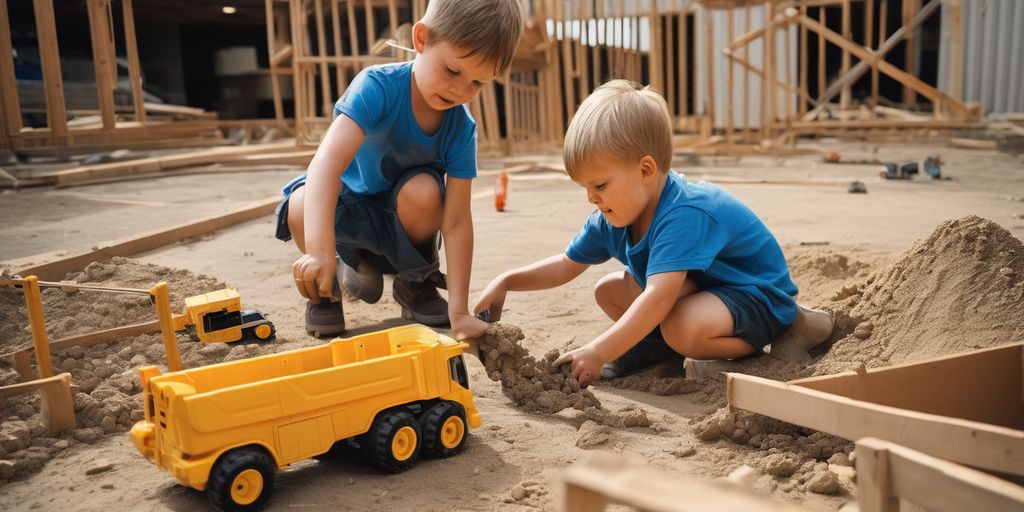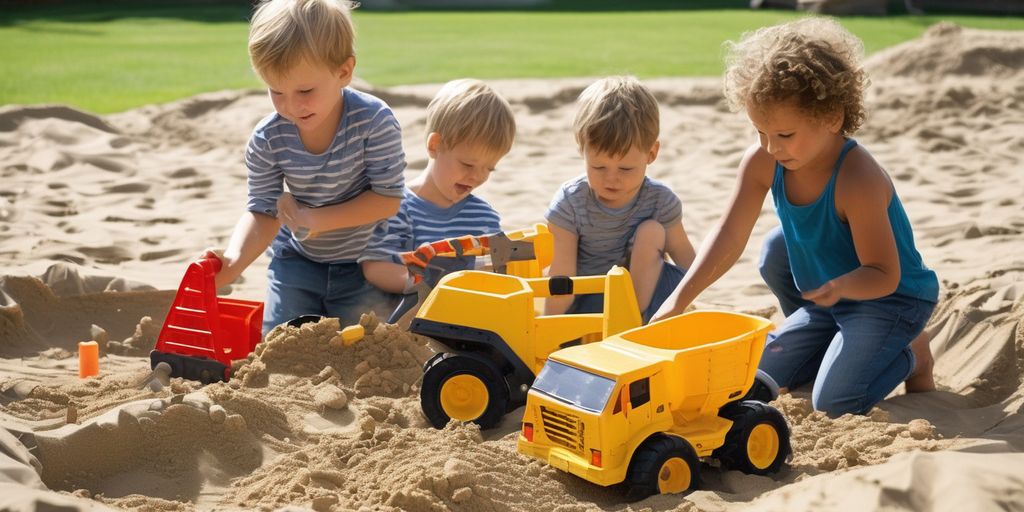Ride-on toys are more than just a source of entertainment for children; they play a crucial role in their overall development. From enhancing physical abilities to fostering cognitive, emotional, and social growth, these toys offer a multitude of benefits. In this article, we will delve into the various ways ride-on toys contribute to children's development and provide insights on how to choose the right one for your child.
Key Takeaways
- Ride-on toys significantly enhance gross motor skills, balance, and coordination.
- They promote cognitive development by improving problem-solving skills and spatial awareness.
- These toys support emotional and social growth by building confidence, encouraging social interaction, and fostering creativity.
- Safety considerations are essential when choosing ride-on toys, including safe materials and design features to prevent accidents.
- Selecting the appropriate ride-on toy for different age groups ensures that children gain the maximum developmental benefits.
The Role of Ride-On Toys in Physical Development
Ride-on toys play an essential part in a child's holistic development, from developing physical abilities to encouraging emotional maturity. Their benefits extend beyond mere entertainment; ride-on toys provide learning tools, exploration avenues, and emotional release tools, ultimately impacting development profoundly.
Enhancing Gross Motor Skills
Ride-on toys promote fine and gross motor skills. Sit and ride toys really accelerate your child’s development. For example, once kids explore the ability for using their arms and legs, there is no stopping them. As they push, pull, pedal, and kick, they delight in their very own new set of wheels! Especially since this means they explore new terrain and experiences.
Improving Balance and Coordination
Ride-on toys can be used to teach children about road safety, spatial awareness, and even basic physics principles like balance and motion. Improving balance and coordination is crucial for a child's physical development, and ride-on toys offer a fun and engaging way to practice these skills.
Boosting Physical Activity
From boosting physical skills to fostering imaginative play, ride-on toys have a lot to offer. They encourage children to be active, helping to build strength and endurance. By choosing an appropriate ride-on toy for your child's age and abilities, you can provide both entertainment and an opportunity for skill development.
Ride-on toys offer more than mere entertainment; they serve as tools for growth and development.
Cognitive Benefits of Ride-On Toys
Ride-on toys provide immediate feedback that keeps children engaged, from steering cause and effect to the thrill of speed. This engagement helps children build longer attention spans and greater capacity for concentration - essential skills that will benefit them both academically and socially.
Problem-Solving Skills
As children navigate their ride-on toys through various obstacles, they are constantly making decisions and solving problems. This process enhances their critical thinking abilities and helps them develop effective problem-solving skills. Setting up obstacle courses or creating tasks that require transporting items from one place to another can further stimulate their cognitive development.
Spatial Awareness
Maneuvering ride-on toys requires children to understand their surroundings and develop spatial awareness. This includes depth perception and hand-eye coordination, which are crucial for many daily activities. By exploring different environments, children learn to gauge distances and navigate spaces more effectively.
Understanding Basic Physics
Ride-on toys offer a practical introduction to basic physics concepts such as motion, speed, and gravity. As children ride and explore, they begin to understand how these forces interact with their movements. This hands-on experience lays the foundation for more complex scientific learning in the future.
To maximize the cognitive benefits, encourage your child to engage in a variety of play scenarios using the ride-on tractor. This could include setting up obstacle courses, creating tasks that require transporting items from one place to another, or encouraging role-play that stimulates their imagination and decision-making skills.
Emotional and Social Growth Through Ride-On Play
Ride-on toys are more than just fun; they play a crucial role in a child's emotional and social development. Shared play experiences such as taking turns riding their favorite motorcycle or organizing group rides can teach children important lessons in fairness, cooperation, and empathy.
Building Confidence and Independence
Resilience can be built through play as children experience minor falls or navigate obstacles, learning to pick themselves back up and try again. Ride-on toys help children gain mental tools for facing larger challenges as they grow, providing a solid foundation of emotional resilience that benefits every aspect of life.
Encouraging Social Interaction
Riding around in a toy car is fun, but riding with friends? That's a whole new level of excitement! Ride-ons encourage social interaction and cooperation as toddlers share, take turns, and navigate space together. Whether it's coordinating a convoy of cars or staging impromptu races, these shared experiences foster friendships and teach valuable social skills like sharing, cooperation, and communication.
Fostering Imagination and Creativity
Personalizing their ride through an app—adjusting elements such as speed, lighting, and music—encourages children to express their individuality while making it indeed their own toy. This process not only enhances their play experience but also brings immense joy and excitement to children, which is contagious and can be felt by parents and caregivers, making the playtime even more enjoyable for everyone.
Ride-on toys like kids motorcycles provide children with more than simple toys; they are essential in encouraging development in all areas. From honing social skills and emotional resilience to increasing confidence and independence, the impact they have on a child's emotional growth is huge and lasting.
Safety Considerations for Ride-On Toys
Choosing Safe Materials
When selecting a ride-on toy, consider these factors:
- Age Appropriateness: Ensure the toy matches the child's age and developmental capabilities.
- Safety Features: Look for stability issues such as non-toxic or protective gear and features like non-slip materials that won't fall off easily.
Design Features to Prevent Accidents
Many ride-on toys feature safety features to promote healthy practices. For instance, the HYPER GOGO Cruiser 12 Plus provides training wheels to encourage stability and customizable settings, enabling parents to ensure the riding experience remains within safe limits. It's important to note that adult supervision is always recommended, and children should wear appropriate safety gear.
Supervision and Safe Play Practices
Parents should ensure that children play with age-appropriate models and wear protective gear if necessary. Supervision is crucial, especially for younger children, to prevent accidents and ensure that play remains a positive, enriching experience.
Tip: Stress the importance of helmets, knee, and elbow pads during play for their protection and well-being. It's also important to teach your child about the potential risks of using ride-on toys, such as falling or colliding with objects, and how to mitigate them, such as by maintaining a safe speed and avoiding rough terrains.
Choosing the Right Ride-On Toy for Different Age Groups
Selecting the appropriate ride-on toy for your child is crucial for their safety and development. The ultimate guide to choosing ride-on toys for every age emphasizes age-appropriate toys for toddlers, preschoolers, and older kids, focusing on safety, development, and maintenance. Below, we break down the best options for different age groups.
Ride-On Toys for Toddlers (1-3 Years)
For toddlers, safety and simplicity are key. Look for toys that are low to the ground and have a stable base. Features to consider include:
- Non-toxic materials
- Non-slip surfaces
- Easy-to-grip handles
Ride-On Toys for Preschoolers (3-5 Years)
Preschoolers are ready for more complex toys that challenge their growing motor skills. Tricycles and small scooters are excellent choices. Key features include:
- Adjustable seats
- Safety gear like helmets
- Sturdy construction
Ride-On Toys for Early School-Age Children (5-8 Years)
Older children can handle more advanced ride-on toys that offer greater speed and maneuverability. Options like bicycles and electric scooters are popular. Important considerations include:
- Advanced safety features
- Durability
- Encouragement of social interaction and skill development
By choosing an appropriate ride-on toy for your child's age and abilities, you can provide both entertainment and an opportunity for skill development.
How Ride-On Toys Encourage Lifelong Skills
Developing Problem-Solving Abilities
Ride-on toys provide immediate feedback that keeps children engaged, from steering cause and effect to the thrill of speed. This engagement helps children build longer attention spans and greater capacity for concentration - essential skills that will benefit them both academically and socially.
Enhancing Communication and Teamwork
When children play with ride-on toys together, they learn to communicate their ideas and work as a team. This collaborative play fosters essential social skills, such as sharing, taking turns, and resolving conflicts. These experiences are crucial for developing effective communication and teamwork abilities that will serve them well throughout their lives.
Promoting Independence and Self-Reliance
Ride-on toys offer more than mere entertainment; they serve as tools for growth and development. By choosing an appropriate ride-on toy for your child's age and abilities, you can provide both entertainment and an opportunity for skill development. To encourage your child to use the toy, start with short supervised sessions and gradually increase the time as they become more comfortable and confident.
Fostering independence and decision making is a key benefit of ride-on toys. As children navigate their surroundings, they learn to make choices and solve problems on their own, promoting a sense of independence and self-reliance.
Conclusion
In conclusion, outdoor ride-on toys are far more than just sources of amusement for children; they are vital tools that contribute significantly to a child's holistic development. From enhancing motor skills and fostering imaginative play to building confidence and promoting social interaction, these toys offer a myriad of developmental benefits. By choosing the right ride-on toy tailored to your child's age and abilities, you can provide an enriching experience that supports their growth in multiple dimensions. So, why wait? Dive into the world of outdoor ride-on toys and watch your child thrive in a fun, safe, and educational environment.
Frequently Asked Questions
What age group is suitable for ride-on toys?
Ride-on toys are designed for various age groups, from toddlers (1-3 years) to early school-age children (5-8 years). It's important to choose a toy that matches your child's developmental stage and abilities.
How do ride-on toys benefit my child's physical development?
Ride-on toys help enhance gross motor skills, improve balance and coordination, and boost physical activity. They encourage children to use their muscles and develop strength and agility.
Are ride-on toys safe for toddlers?
Yes, ride-on toys can be safe for toddlers if they are designed with safety features such as low centers of gravity, wide bases to prevent tipping, smooth edges, and non-toxic materials. Always supervise your child during play.
Can ride-on toys help with my child's cognitive development?
Absolutely. Ride-on toys can improve problem-solving skills, spatial awareness, and understanding of basic physics principles like balance and motion. They offer a fun way to learn through play.
How do ride-on toys contribute to emotional and social growth?
Ride-on toys can build confidence and independence, encourage social interaction, and foster imagination and creativity. They provide opportunities for children to explore and interact with their environment and peers.
What should I consider when choosing a ride-on toy?
When choosing a ride-on toy, consider the child's age, developmental stage, and interests. Look for safety features, durability, and engaging design elements that will keep your child interested and safe during play.



Leave a comment
This site is protected by hCaptcha and the hCaptcha Privacy Policy and Terms of Service apply.